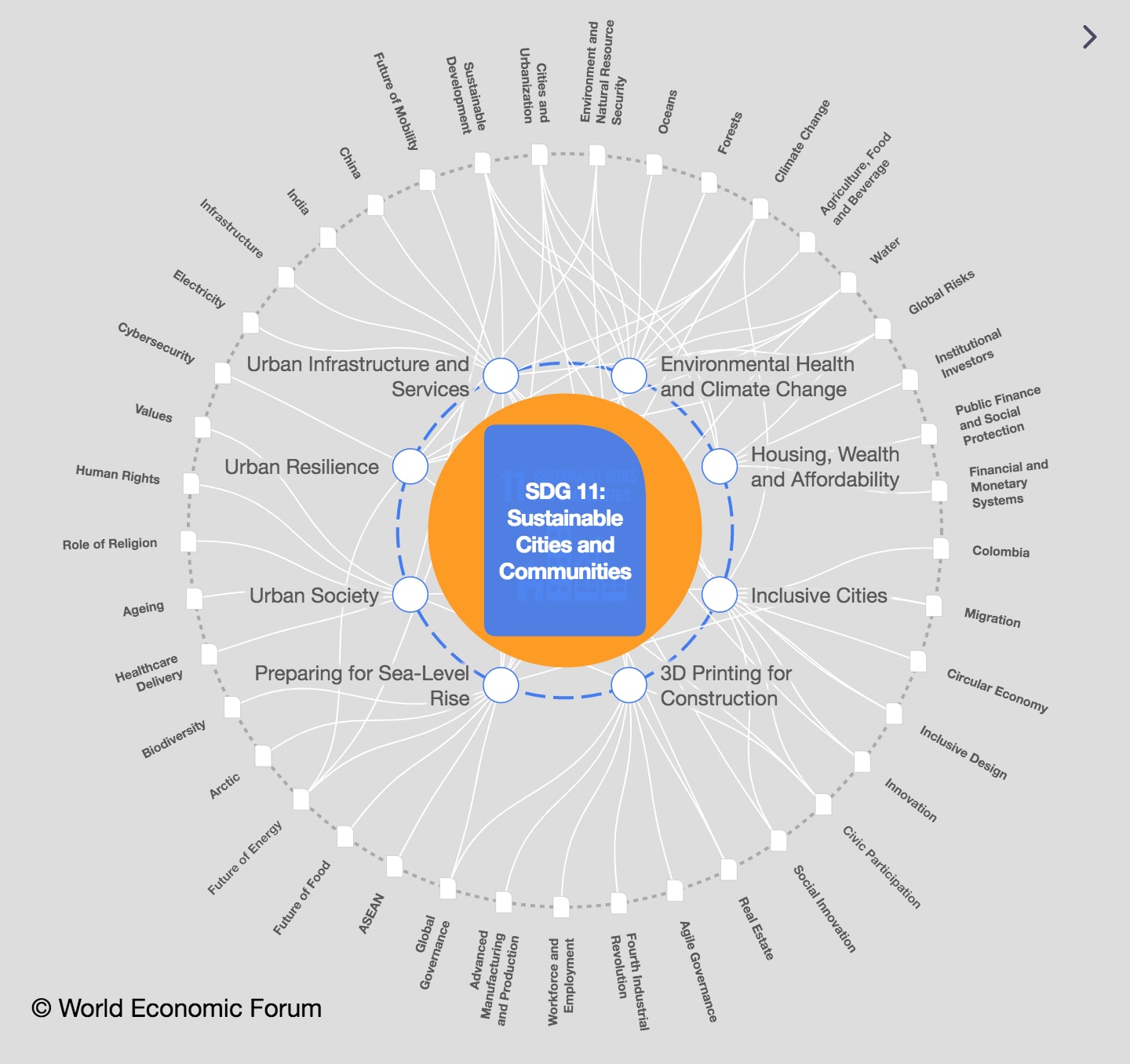Nature-based solutions in cities are the future of the fight against climate change. Here's how to fund them

Cities can use nature-based solutions to boost their resilience against climate change, at a lower cost. Image: Cande Westh on Unsplash
Listen to the article
- 80% of cities worldwide are facing extreme climate-related events.
- Nature is the most resource-efficient solution to help build resilient, vibrant and future-proof cities.
- But implementing nature-based solutions needs funding — here are five ways we can fund the green transition.
Mayors from Latin America, Africa and Asia will be welcoming more than 90% of the new urban inhabitants in the next decade. Governing these ballooning cities is a continuing challenge, not just in terms of urban design and revitalisation, but in terms of preparedness for climate change.
80% of cities worldwide now face extreme climate-related events, and more than 1.4 billion people living in the world’s largest urban centres are threatened by natural hazards.
The pivotal role of cities in leading the global fight against climate change is well established, but a critical missing part is the nerve point for climate-proofing: healthy ecosystems.
Nature: the most cost-effective solution
Cities’ inhabitants are highly dependent on nature’s contributions to their health, happiness, prosperity and security. Because cities and citizens rely on nature, they have much to gain from protecting it. Cities are struggling to meet the needs of growing economies and populations, and nature can help.
Investment needs for urban infrastructure at a global level are estimated at $4.5-5.4 trillion per year, which translates into an estimated funding gap of $350 billion per year compared to current levels of infrastructure investment. Nature-based solutions (NbS) for infrastructure are 50% cheaper than traditional man-made infrastructure, and provide 28% added value — including decarbonisation of the built environment, climate resilience, land value capture and job creation. Despite the proven benefits, less than 0.3% of current spending on urban infrastructure is going to NbS.
Spending shortfalls in NbS and unfit interventions can have shattering effects, not only in terms of growth but also in our cities’ stability. It is critical that cities and states everywhere deploy natural climate solutions in the upgrade and development of infrastructure.
5 steps for funding nature-based solutions in cities
Multi-stakeholder and cross-sector partnership could increase investment in nature-based solutions for urban resilience and solve structural urban challenges. Five things are needed for this to happen:
1. Reform financial infrastructure.
Some cities lack the budgetary autonomy to pursue nature-based investment in infrastructure and climate action. Budgetary autonomy allows cities to address upcoming climate, nature and social infrastructure challenges.
During the COVID-19 pandemic, Melbourne and Quito took advantage of national, regional and municipal funding opportunities to integrate climate action into the recovery efforts, developing and implementing plans for active mobility and bike infrastructure. Cities without enough resources to qualify for finance using traditional measures of creditworthiness may benefit from emerging and novel financial mechanisms.
International institutions and private investors should engage directly with cities and develop innovative vehicles targeting the areas of greatest need. By linking funding to positive social and nature outcomes, city investment plans and private financing vehicles are based on science-based climate goals and equity principles. They must promote resilience to shocks, from pandemics to climate change, and anticipate the expected impacts of urban growth, from informal settlements to migration changes and beyond.
2. Identify investment-ready projects.
Only between 2% and 9% of adaptation finance went to identifiable climate adaptation projects, with less than 1% of it going to Sub-Saharan Africa and less than 3% to South America. Good will is not enough; nor are solutions on paper or policy recommendations.
Cities are capable of cutting emissions, mitigating and adapting to climate change and increasing investment in nature-based solutions for urban infrastructure, but active implementation is fundamental. We must lay the groundwork with bankable projects. Cities need standardised processes and ways to bundle projects to achieve economies of scale. Projects will be easier to scale and more attractive for investment if they are aggregated from city- and investor-led perspectives.
It is important to come together and build a coalition that can enact such a pathway, including policies, financial mechanisms and spatial interventions. This includes curating successful models of public-private collaboration that can be scaled globally, building the capacity of local governments and piloting new approaches for joint planning and co-investment.
Identifying tried and tested solutions and incorporating dedicated nature and climate teams must be paired with nature-positive investments.
3. Policy and legal reform.
Incentivising nature-positive investments and projects with tax breaks and smart subsidies while regulating harmful interventions is essential.
A wide range of experts and stakeholders, from activists to corporate leaders, must be engaged in the process of incorporating nature-positive standards and considerations into legislation and regulatory frameworks.
Policy and legal reforms represent a major step in ensuring that sustainable practices are implemented widely and that safer and more resilient urban environments are deployed.
Investing in research and development (R&D) should also be a priority to enhance competitiveness, foster innovation and accelerate the sustainable transition. The construction sector is traditionally considered conservative and low-tech due to the lack of research & development (R&D) investment — estimated to be in low single digits as a percentage of revenue. Here tax relief – such as the UK’s tax credits on R&D activity in the innovative use of green methods — can help encourage investment in growth and sustainable innovation.
4. Develop partnerships with business.
Compared with traditional procurement solutions, public-private partnerships (PPP) stand out for boosting the efficiency and effectiveness of projects through their entire life cycle.
As a necessary complement to public sector planning and investment efforts, the private sector is uniquely positioned to develop innovative solutions, given its knowledge of markets and experience in transferring advanced technologies into products.
Hydromedia for example, a permeable concrete designed by Holcim, is one such solution that absorbs water at an exceptionally rapid rate and helps recycle rainwater, preventing flood and reducing the heat island effect at the same time — this is a private sector innovation with clear applications in public sector and infrastructure projects.
Likewise, Sony has experimented with augmented ecosystems and introduced over 200 species of plants into rooftop gardens in a building complex in Tokyo, recreating natural ecosystems in the urban environment with the help of artificial intelligence.
5. Ensure inclusive decision making and co-design.
Every stakeholder — governments, companies, local communities or civil society groups — has a role to play in scaling up urban nature-based solutions, and partnerships are key to amplifying their benefits.
The Sino-Singapore Tianjin Eco-City, built in a former industrial dumping ground, is an example of this. Extensive green and blue networks will create a green lung at the core of the city and ensure greater water circulation and water quality, improving the ecological environment and meanwhile providing an attractive environment for business and recreational activities.
Freetown addressed its own limitations in the City Council by drawing on community participation and voluntary technical expertise, to collect evidence and build a business case for the ambitious Transform Freetown programme.
For sustainable cities, finance nature-based solutions
Our cities are on the frontlines of the triple planetary crises of climate change, pollution and biodiversity loss. We must take immediate action to tackle these challenges.
Nature-based solutions are fundamental to achieving the UN’s Sustainable Development Agenda and addressing the impacts of climate change, benefiting ecosystems and the health and well-being of our citizens and the economy. Investing in nature is fundamental to accelerating climate action and ecosystem restoration.
The time for talk is over. Nature is key to people, the economy and the planet, and cities are at the frontlines. To protect cities and their inhabitants — and build a better world for all — they must be provided the means and funding to implement nature-based solutions.
This article is part of the BiodiverCities by 2030 initiative and the global commitment for increasing investment in nature for cities' resilience. It has been developed in collaboration with UN Environment Programme, University of Pennsylvania, ICLEI, C40, Global Environment Facility, Climate Policy Initiative’s CCFLA, Resilient Cities Network and the Adrienne Arsht-Rockefeller Foundation Resilience Center.
Don't miss any update on this topic
Create a free account and access your personalized content collection with our latest publications and analyses.
License and Republishing
World Economic Forum articles may be republished in accordance with the Creative Commons Attribution-NonCommercial-NoDerivatives 4.0 International Public License, and in accordance with our Terms of Use.
The views expressed in this article are those of the author alone and not the World Economic Forum.
Stay up to date:
SDG 11: Sustainable Cities and Communities
Related topics:
Forum Stories newsletter
Bringing you weekly curated insights and analysis on the global issues that matter.
More on Forum in FocusSee all
Gayle Markovitz
October 29, 2025







